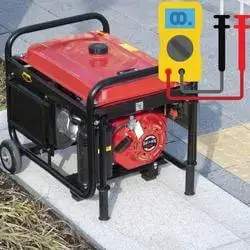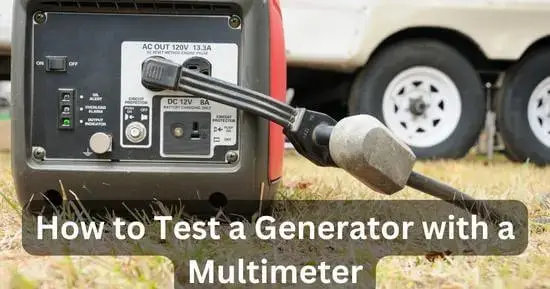If you own a generator, it’s essential to ensure it works correctly before an emergency strikes. One way to test your generator’s performance is by using a multimeter. This guide will show you how to test a generator with a multimeter. With our instructions, you can confidently measure the key readings and troubleshoot any issues you may encounter to keep your generator running smoothly.
Electrical generators can be tested using voltmeters, ohmmeters, and amperage meters. However, using all tools can lead to an expensive test that will be quite complicated for the non-specialist.
A generator can cause trouble because of so many problems, so to have a deep check on the root cause, it is necessary to perform different tests on it to determine whether the issues in the generator can occur because of the uneven supply of the current or because of the jam of oil in the motor and many other reasons.
Using the digital multimeter to test the generator deeply will be beneficial even for the person who does not have much information about using the digital multimeter. It will be easy to use and a cheap way to test a generator thoroughly.
Table of Contents
ToggleTypes of tests for genrator:
There are a total of Three types of tests that you can perform to check or test the condition of the generator. These tests will make you realize the real cause of your generator’s problem and help you choose the perfect solution for the problem easily. These tests are
- Resistance test:
A resistance test is done on the generator by using the digital multimeter. This is done to check the value of resistance between the coils. The resulting doubtful readings will need you to replace the alternator of your generator.
- Voltage test:
The second test which you have to perform here is the voltage test. If the required voltage reaches the generator, then it means that the voltage is not the issue.
- Amperage test:
Although an amperage test is not necessary, if you have a digital multimeter, then performing this test will benefit you.
The most useful test for the generator is the voltage test which is done for different car generators along with portable generators also.
How to test a generator with the multimeter?
Tools required:
Using the digital multimeter, you will not have to arrange many things while testing the generator. You should only have a working digital multimeter, and then you can perform this test without any hurdles.
Preventive measures:
As you are dealing with an electrical appliance, you must consider some preventive measures before starting the test on the generator.
- Gloves
- Non-conductive soled shoes
Here are quick steps overview to test the generator with the multimeter
You can perform this test on 6 or 12 volts and portable generators.
- Set the digital multimeter on the alternative voltage settings
- Set the AC voltage range between 0 to 20 volts for a 12-volt generator and 0 to 10 volts for a 6 volts generator on the digital multimeter.
- Turn the ignition switch ON which will turn the generator on.
- Connect the leads of the digital multimeter with the terminals of the generator.
- Check the readings of the voltage from the display screen
- For a 6 volts generator, the normal readings will be between 7 to 8, and for a 12 volts generator, the normal reading will be between 11 to 13 volts.
- Turn off the electricity supply to the generator.
Lets read below step by step guide to test generator with multimeter:
How to test a generator with the multimeter (step-by-step explanation)
Step 1: Set the digital multimeter
To test the alternative voltage value of the generator, the digital multimeter should be set on the voltage settings. For this, you have to turn the selection knob of the digital multimeter towards the AC voltage symbol V~.
After setting the digital multimeter on the AC voltage settings, you can now measure the AC voltage of your portable car generator.
Step 2: Set the range
To test the AC voltage of the 12 volts generator, you have to set the range of the digital multimeter between 0 to 20 volts. This will help you to test the AC voltage without damaging the multimeter.
If you are testing a 6 volts generator, you must set the digital multimeter range between 0 and 10 volts. It will be beneficial to test the 6 volts generator using the digital multimeter under this range.
Step 3: Turn the generator on
To test the value of the AC voltage of your generator, you have to turn the ignition switch of your generator to the ON position so that your generator will also get started.
You cannot measure the generator’s voltage when it is off, so you have to turn it on to measure the AC voltage of the generator accurately.
Step 4: Connect the leads
To measure the AC voltage of the generator by using the digital multimeter, it is important to connect the digital multimeter’s leads with the generator’s terminals.
- For a portable generator:
You have to connect the digital multimeter’s red lead with the generator’s positive terminal and the black lead of the digital multimeter with the negative terminal of the generator.
- For a 6-volt generator:
You have to connect the digital multimeter’s red lead with the generator’s positive terminal and the black lead of the digital multimeter with the negative terminal of the generator.
- For a 12-volt generator:
Now you have to connect the red lead with the “B” labeled terminal of the generator, which is a positive terminal, and the other black lead should be attached to the negative Gnd terminal of the generator.
Step 5: Check the readings
After connecting the digital multimeter with the appropriate terminals of the generator, you have to look at the displaced screen of the digital multimeter, which will tell you about the exact voltage readings of your generator.
- For a 6-volt generator:
The normal voltage readings should be between 7 to 8 volts. If the readings are lower than 7 volts, then it means that there is some problem with the generator.
- For a 12-volt generator:
The normal voltage reading should be between 11 and 13 volts. If the resulting voltage readings are lower than 11 volts, then it means that the generator has a problem with it.
How to Test the AVR of the generator?
After testing the voltage of your generator and finding out the condition that the resulting voltage readings on the digital multimeters are lower than the normal voltage readings of your generator.
Now have to move toward the next step of testing the automatic voltage regulator of your generator.
Materials required:
- Alligator clips
- Electric tape
- DC power source
- gloves
To test the automatic voltage regulator, follow the following steps.
- Disconnect the leads connecting the automatic voltage regulator and the brush set.
- Cover the ends of the black and red leads of the AVR with electrical tape.
- Take the DC power source of 12 volts and connect it with the brush set of the generator by using the alligator clips.
- Only connect the positive line of the brush set to the battery
- The generator is on for 10 seconds and then connects the other negative line also
- Set the digital multimeter on the voltage settings by rotating the selection knob toward the voltage symbol
- Connect the digital multimeter leads with the generator’s terminals from where you have disconnected the AVR.
- Suppose the automatic voltage regulator of your generator is fine. In that case, you will get the resulting voltage readings of around 60 volts, and if you do not get this many readings in the result, you have to replace the automatic voltage regulator of your generator.
Final verdict
An electrical generator has different sensitive parts that can get damaged and cannot let the generator run properly by stopping the required voltage and electricity from reaching the generator’s motor. No matter if you are testing a small generator or a big generator, complexities are always there.
If you do not want to waste time on unwanted tests, you are advised to check the generator’s battery and the automatic voltage regulator. These two are the most sensitive parts to damage.
If you have performed both tests and everything is going well, then you have to have your generator checked by a professional. Your generator may have another issue that needs a proper inspection or repair.
Related Guides:




